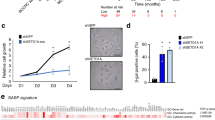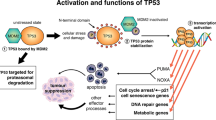Abstract
14-3-3σ is a member of a family of proteins that regulate cellular activity by binding and sequestering phosphorylated proteins. It has been suggested that 14-3-3σ promotes pre-mitotic cell-cycle arrest following DNA damage, and that its expression can be controlled by the p53 tumour suppressor gene1. Here we describe an improved approach to the generation of human somatic-cell knockouts, which we have used to generate human colorectal cancer cells in which both 14-3-3σ alleles are inactivated. After DNA damage, these cells initially arrested in the G2 phase of the cell cycle, but, unlike cells containing 14-3-3σ, the 14-3-3σ-/- cells were unable to maintain cell-cycle arrest. The 14-3-3σ-/- cells died (‘mitotic catastrophe’) as they entered mitosis. This process was associated with a failure of the 14-3-3σ-deficient cells to sequester the proteins (cyclin B1 and cdc2) that initiate mitosis and prevent them from entering the nucleus. These results may indicate a mechanism for maintaining the G2 checkpoint and preventing mitotic death.
This is a preview of subscription content, access via your institution
Access options
Subscribe to this journal
Receive 51 print issues and online access
$199.00 per year
only $3.90 per issue
Buy this article
- Purchase on Springer Link
- Instant access to full article PDF
Prices may be subject to local taxes which are calculated during checkout





Similar content being viewed by others
Change history
22 August 2023
A Correction to this paper has been published: https://doi.org/10.1038/s41586-023-06446-1
References
Hermeking,H. et al. 14-3-3σ is a p53-regulated inhibitor of G2/M progression. Mol. Cell 1, 3–11 (1997).
Busler,D. E. & Li,S. W. Rapid screening of transgenic type II and type XI collagen knock-out mice with three-primer PCR. Biotechniques 6, 1002–1004 (1996).
Waldman,T., Kinzler,K. W. & Vogelstein,B. p21 is necessary for the p53-mediated G1 arrest in human cancer cells. Cancer Res. 55, 5187–5190 (1995).
Heald,R., McLoughlin,M. & McKeon,F. Human wee1 maintains mitotic timing by protecting the nucleus from cytoplasmically activated cdc2 kinase. Cell 74, 463–474 (1993).
Pines,J. Cell cycle: checkpoint on the nuclear frontier. Nature 397, 104–105 (1999).
Nurse,P. Universal control mechanism regulating onset of M-phase. Nature 344, 503–508 (1990).
Hagting,A., Karlsson,C., Clute,P., Jackman,M. & Pines,J. MPF localization is controlled by nuclear export. EMBO J. 17, 4127–4138 (1998).
Jin,P., Hardy,S. & Morgan,D. O. Nuclear localization of cyclin B1 controls mitotic entry after DNA damage. J. Cell Biol. 141, 875–885 (1998).
Honda,R., Ohba,Y. & Yasuda,H. 14-3-3 zeta protein binds to the carboxyl half of mouse wee1 kinase. Biochem. Biophys. Res. Commun. 230, 262–265 (1997).
Peng,C. Y. et al. Mitotic and G2 checkpoint control: regulation of 14-3-3 protein binding by phosphorylation of Cdc25C on serine-216. Science 277, 1501–1505 (1997).
Gardner,R., Putnam,C. W. & Weinert,T. RAD53, DUN1 and PDS1 define two parallel G2/M checkpoint pathways in budding yeast. EMBO J. 18, 3173–3185 (1999).
Toyoshima,F., Moriguchi,T., Wada,A., Fukuda,M. & Nishida,E. Nuclear export of cyclin B1 and its possible role in the DNA damage-induced G2 checkpoint. EMBO J. 17, 2728–2735 (1998).
Fukuda,M. et al. CRM1 is responsible for intracellular transport mediated by the nuclear export signal. Nature 390, 308–311 (1997).
Fornerod,M., Ohno,M., Yoshida,M. & Mattaj,I. W. CRM1 is an export receptor for leucine-rich nuclear export signals. Cell 90, 1051–1060 (1997).
Lopez-Girona,A., Furnari,B., Mondesert,O. & Russell,P. Nuclear localization of Cdc25 is regulated by DNA damage and a 14-3-3 protein. Nature 397, 172–175 (1999).
Waldman,T., Lengauer,C., Kinzler,K. W. & Vogelstein,B. Uncoupling of S phase and mitosis induced by anticancer agents in cells lacking p21. Nature 381, 713–716 (1996).
Bunz,F. et al. Requirement for p53 and p21 to sustain G2 arrest after DNA damage. Science 282, 1497–1501 (1998).
Reynisdottir,I., Polyak,K., Iavarone,A. & Massague,J. Kip/Cip and Ink4 Cdk inhibitors cooperate to induce cell cycle arrest in response to TGF-beta. Genes Dev. 9, 1831–1845 (1995).
El-Deiry,W. S. et al. WAF1, a potential mediator of p53 tumor suppression. Cell 75, 817–825 (1993).
Nurse,P. Checkpoint pathways come of age. Cell 91, 865–867 (1997).
Acknowledgements
We thank the members of the Vogelstein/Kinzler Laboratory for helpful discussions. We thank M. Yoshida for the gift of leptomycin B and D. Tomasallo for helpful advice. Under an agreement between CalBiochem and Johns Hopkins University, K.W.K. and B.V. are entitled to a share of the sales royalty for the p21 antibody received by the University from CalBiochem. The terms of these arrangements are managed by the University in accordance with its conflict of interest policies. This work was supported by the Clayton Fund, the Medical Scientist Training Program and the NIH.
Author information
Authors and Affiliations
Corresponding author
Rights and permissions
About this article
Cite this article
Chan, T., Hermeking, H., Lengauer, C. et al. 14-3-3σ is required to prevent mitotic catastrophe after DNA damage. Nature 401, 616–620 (1999). https://doi.org/10.1038/44188
Received:
Accepted:
Published:
Issue Date:
DOI: https://doi.org/10.1038/44188
This article is cited by
-
Chemosensitivity to doxorubicin in primary cells derived from tumor of FVB/N-Trp53tm1Hw1 with TALEN-mediated Trp53 mutant gene
Laboratory Animal Research (2023)
-
Targeting CDK1 in cancer: mechanisms and implications
npj Precision Oncology (2023)
-
Hornerin mediates phosphorylation of the polo-box domain in Plk1 by Chk1 to induce death in mitosis
Cell Death & Differentiation (2023)
-
Characterization of stem cell subtypes and prognostic signature in hepatocellular carcinoma
Journal of Cancer Research and Clinical Oncology (2023)
-
Stratifin as a novel diagnostic biomarker in serum for diffuse alveolar damage
Nature Communications (2022)
Comments
By submitting a comment you agree to abide by our Terms and Community Guidelines. If you find something abusive or that does not comply with our terms or guidelines please flag it as inappropriate.



